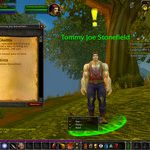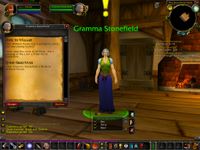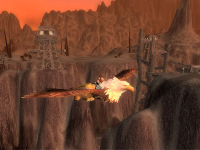A Network of Quests in World of Warcraft

Jill Walker argues that although the quests in World of Warcraft lack the narrative or linguistic sophistication that we expect from literary texts, the sustained attention that players give to games equates with the attentiveness that readers give novels (or at least that readers once gave novels - back when novels had readers).
I’m Yggdra, a human warrior in World of Warcraft. I’m also an undead rogue and a dwarven warrior and a night elf hunter, but they’re only my alts: my main character lives in Elwynn Forest, where she’s well on the way to becoming one of the Alliance’s staunchest defenders. She’s also spending a surprising amount of time mining and blacksmithing to earn money for all the training and equipment her warrior career requires.
Like many other games, World of Warcraft is organized through its quests (Tronstad 2001; Tosca 2003; Aarseth 2004). Within seconds of logging on for the first time, I saw my first non-player character with a yellow exclamation mark over his head. Clicking him set my first quest into motion, with a short narrative, some fixed objectives, and a resolution. The quests I’ve experienced so far have all been designed to spur me on to discover more of the game in fairly limited ways, and all instruct me either to:
1. Explore, by: a. Finding a person (report to a person, deliver an object to a person). b. Exploring an area (scout an area, report back and tell us the condition). c. Learning to use a game function, such as buying an item from a vendor, finding flight routes, playing dungeon instances, or joining the skirmishes on the battlefields. 2. Slay monsters, with slight variations: a. Kill X number of a particular kind of monster. b. Bring the quest-giver an object that is found on the body of a slain monster. c. Bring the quest-giver an object that is found in a monster-infested area. This also involves exploring, of course.
Sometimes these are combined (“Escort this NPC through a monster-infested area and slay monsters to keep him alive until he shows you a new area of the game” combines 1a and 1b; 1b tends to involve monster-slaying in order to fully explore the required territory), but they can always be broken down into these basic structures.
World of Warcraft has a very explicit quest management system. At any time, I can pull up my quest window, and see which quests I have accepted, how much progress I’ve made on them and even whether I’m likely to succeed at the quest playing solo or should team up with other players. Additional organization of the quests is provided less explicitly: some quests build upon other quests, some quests are only for specific races, classes, or professions (humans, warriors, miners), and related quests can be found close to each other in the in-game geography.
Each quest in World of Warcraft sets up a capsule narrative situation. The person who gives you the quest will always have a short dialogue. One of my favorite series of quests from the early levels of the game began, for me, when Maybell Maclure at the Maclure Vineyard near Goldshire asked me to help her:
Oh, I’m cursed! My heart belongs to Tommy Joe Stonefield, but our families are bitter enemies. So I can’t see him, even though my eyes ache to gaze upon that handsome face! Please, take this letter and give it to Tommy Joe. He’s usually at the river to the west of the Stonefield Farm, which is due west of here. (“Young Lovers”)
Figure 45.1. Two images from related quests in World of Warcraft. (Blizzard)
The writing is poor and the plot is unoriginal and predictable, so why did this engage me so? I was admittedly thrilled to find a quest that seemed to break the already dull slay-more-monsters mold, but the basic structure is a straightforward example of quest type 1a, “Deliver an object to a person.”
In trying to see what is appealing about this series of quests, I quickly ruled out the quality of the plot and the aesthetic pleasure of the language. If that were what I was after, any novel would be an improvement. Is it my engagement with the plot, then? My agency? Well, I really only have two choices: decline or ignore the quest, or accept it and walk over to Tommy Joe. If I try to complete the quest, I’m really just enacting whatever role the game designers devised.
What most appealed to me about the series of quests between the Maclure Vineyard and Stonefield Farm was the abundance of stories I discovered and the tight network between the quests in the series. As I was working on helping Maybell and Tommy Joe to get together, other members of their families asked me for help. One had lost a necklace, which led to my having to slay boars so that she could bake a pie for the horrid little boy at the neighboring farm, who refused to tell me where he’d lost the necklace he’d stolen from her, unless I got him that particular pie. Finally, he told me that a vicious kobold in the nearby mines had it, so off I went, back to the same mines I had already scouted in a previous quest, with a new goal.
Another storyline is introduced in “Princess Must Die,” where I had to go to another farm and kill the pig Princess, but since bandits had taken over the pig’s farm, that required teaming up with other players. Each time I achieved one goal, a new objective was given to me, and I trotted back and forth between the two family farms dozens of times to complete all the quests set up between them. Through this abundance of quests and stories in the area, a whole world was set up, where I gradually came to know a little about many of the people at these farms. Certainly, Maybell and her family stand like stiff cardboard cut-outs simply waiting for me to come and find them, but I know the farms and the mine south of the road leading east from Goldshire as intimately as you do, only when you know the stories of a place.
The different zones of World of Warcraft each have their own set of stories, and some are far more appealing than others. Playing my dwarven warrior, I quickly tired of the less-connected stories in the dwarven starting areas, and as soon as I could I traveled to Westfall, the zone adjacent to Elwynn Forest, meant for the slightly more experienced characters. As soon as I arrived there, I found that the people in the general chat channels agreed with me. “Westfall is much more fun than Loch Modan!” someone said, confirming my opinion.
Westfall, like the family farms in Elwynn Forest, has clusters of quests that work together well, and that build up a sense of knowing an area and making a difference to the people who live there. The most likely point of entrance for players reaching the appropriate level of experience is from Elwynn Forest, because the other entrances are from zones with far higher-level monsters that are hard for newbies to cross.
Crossing from Elwynn Forest into Westfall, everything changes. The countryside becomes burnt and red and dry, the sounds are of hot roads baked in sun and crickets, and the music becomes more ominous. The first NPCs you meet are a farming couple who’ve been evicted from their houses by bandits. Farmer Furlbrow asks you to find his pocket watch, a family heirloom left in their former home that has been taken over by bandits (quest type 2c), while his wife asks you to take a recipe to a friend nearby. Each of these quests takes you to places where you’ll find many other quests and snippets of story. Westfall is densely populated by characters and quests that almost all center on the land, which the people no longer control. The militia tell you that the king no longer controls these lands, and asks you to help fight the bandits. Again, each of the capsule narratives seen alone is rather pathetic, but together they work wonderfully.
Of course, we might wish for games where the individual quests were better written, but the true importance of quests in World of Warcraft is not at the level of the individual quest. There are at least two reasons we need quests. First, they function as tutorials guiding the player through learning how to play the game and expanding the game as the player progresses. Secondly, they flesh out the world, making it interesting. They do that not so much through each individual quest as through the densely storied landscape that I come to know as I work through quest after quest.
Grand Theft Auto is another quest-based series of games. In Grand Theft Auto, quests are called “missions,” and of course, it’s a single-player game, but apart from that it has much in common with World of Warcraft. The player can choose from a series of quests, not all of which are compulsory. There are always other options than doing quests. You can simply explore the world, car-jacking in Grand Theft Auto and walking (and later, flying) in World of Warcraft. You can earn money through taxi-driving in Grand Theft Auto and through a myriad of professions in World of Warcraft. You can work out and train, and you can buy yourself clothes and gadgets. You can fight monsters without having any quest to do so.
This semi-structured organization through a network of quests and always-available self-selected activities within set boundaries matches the way we read and experience the world today. These days, we do things in fragments: we surf, channel-flip, and multitask. We write and read e-mails and blog posts rather than novels, we listen to four- to six-minute songs rather than symphonies, and we listen to the news in thirty-second sound bites. We devour these fragments, flicking through hundreds each day, and we return to many, maybe only spending a few minutes at a time on one topic or blog or news story, but returning to it again and again. This fragmentation doesn’t necessarily mean that we’re more superficial. We return to things again and again, and the accumulation of fragmentary experiences may be as deep or deeper as a single, but lengthier, exposure to a work.
An increasing number of narratives and art works are designed for this kind of fragmentary yet cumulative reading. Online Caroline is meant to be read for five or ten minutes a day over a period of about three weeks (Walker 2004). The Impermanence Agent (Wardrip-Fruin et al. 2000) pops up while you’re doing other things, David Claerbout’s The Present (2000) grows quietly on your desktop, only visible in between other tasks, and the novel Implementation (Montfort and Rettberg 2004) is told in 192 stickers stuck in public places around the world. Weblogs, one of the first native web genres, provide a perfect example of a work that is completely composed of fragments that don’t necessarily have anything in common except for the visual design and, perhaps, a common narrative voice.
This form of storytelling (or story-collection, from the player’s point of view) has much in common with the distributed narratives that are becoming more and more common in other genres as well (Walker 2005). Outside of the game world, there are hundreds of fan Web sites with searchable databases of all possible quests. The quests in World of Warcraft are not puzzles, so there are no walkthroughs for the game. Instead, there are maps of where to find the starting points for quests, or where to find objects you need. There are discussions of which quests are the most satisfying, and for the rarer quests (which are started by a random “drop” from a monster, for instance) there are discussions about how many murlocs you have to kill, on average, in order to find the treasure map or other item that starts the quest. These discussions are reminiscent of the ways in which fans of the Space Invaders project share the pleasure of the hunt for the mosaics around the world that is each part of the project (Walker 2005).
On the surface, video games might appear the exact opposite of today’s fragmentary expression. They routinely last for at least forty hours of play, and the popular image of the gamer is of a person in deep, continuous concentration. Indeed, a recurring story reported in newspapers is of the gamer who dies from having played for too long, too intensively. This would appear to be precisely the sort of concentration on a single cultural object of which protectors of traditional novel reading have lamented the loss (Birkerts 1994).
Look more closely, though, and you’ll find that a game is a network of fragments, most of which are not necessary to experience the game fully, and yet which cumulate into a rich experience of a storied world.
Figure 45.2. The World of Warcraft. (Blizzard)
References: Literature
Aarseth, Espen (2004). “Beyond the Frontier: Quest Games as Post-Narrative Discourse.” In Narrative Across Media: The Languages of Storytelling, edited by Marie-Laure Ryan. Lincoln: University of Nebraska Press.
Birkerts, Sven (1994). The Gutenberg Elegies: The Fate of Reading in an Electronic Age. Boston: Faber and Faber.
Claerbout, David (2000). The Present.
Montfort, Nick, and Scott Rettberg (2005). Implementation.
Tosca, Susana (2003). “The Quest Problem in Computer Games.” Darmstadt: Paper read at Technologies for Interactive Digital Storytelling and Entertainment (TIDSE).
Tronstad, Ragnhild (2001). “Semiotic and Nonsemiotic MUD Performance.” Amsterdam: Paper read at COSIGN.
Walker, Jill (2004). “How I was Played by Online Caroline.” In First Person: New Media as Story, Performance, and Game, edited by Noah Wardrip-Fruin and Pat Harrigan. Cambridge, MA: MIT Press.
Walker, Jill (2005). “Distributed Narrative: Telling Stories Across Networks.” In The 2005 Association of Internet Researchers Annual, edited by M. Consalvo, J. Hunsinger, and N. Baym. New York: Peter Lang.
Wardrip-Fruin, Noah, a.c. chapman, Brion Moss, and Duane Whitehurst (2000). The Impermanence Agent.
References: Games
Online Caroline. R. Bevan and T. Wright. 2000/2001.
Cite this essay
Walker, Jill. "A Network of Quests in World of Warcraft" Electronic Book Review, 20 April 2008, https://electronicbookreview.com/publications/a-network-of-quests-in-world-of-warcraft/


